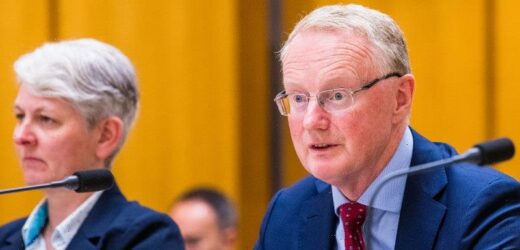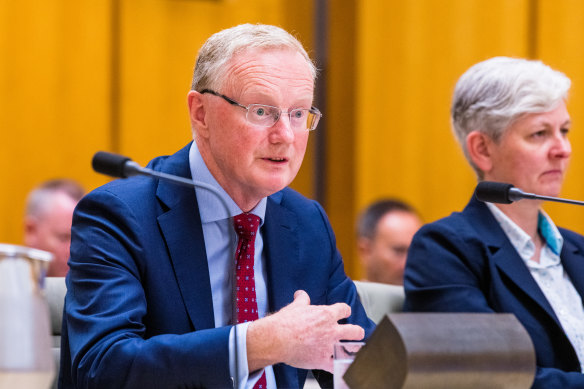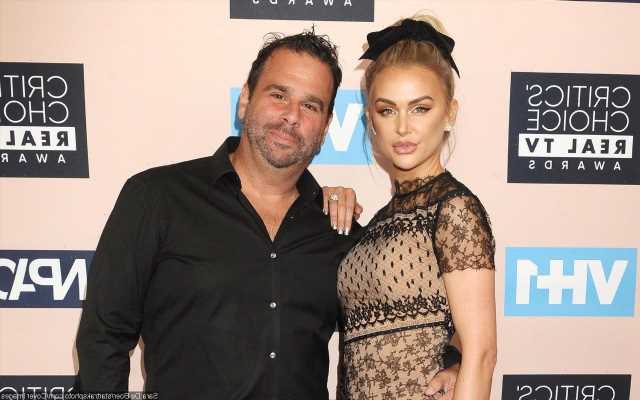About 10 per cent of Australian mortgage holders are hurting after the recent steep rise in interest rates, but about half of homeowners with variable loans are more than a year ahead on their repayments.
Reserve Bank assistant governor Brad Jones said the mortgage stress picture was “very uneven”, with about a third of variable rate owner-occupiers more than two years ahead on their mortgage payments.
RBA governor Philip Lowe kicked off his appearance before the House committee by explaining why the interest rate hikes have been necessary.Credit:James Brickwood
“At the other end of the distribution, we observe around 10 per cent of variable rate owner-occupier borrowers who have got virtually no spare cash flow after they make their mortgage payments and their living costs. They also have very low buffers,” he told the House of Representatives economics committee on Friday.
“There’s no question that there’s a segment of the community that are hurting now and that’s very likely to continue. That certainly features very prominently in our internal discussions.”
The Reserve Bank has been under fire since lifting the official cash rate at a record nine consecutive meetings, taking it from 0.1 per cent in April to 3.35 per cent this month as it tries to bring inflation under control. Inflation reached 7.8 per cent in December, the highest rate since 1990.
At the same time, house prices have been falling, sparking concerns some borrowers may be in negative equity – where they owe more on their home loan than their property is worth.
But Jones said currently fewer than half a per cent of mortgaged households were in negative equity.
“When we run a stress scenario, if prices were to fall from this point another 10 per cent,
the share of loans that would be in negative equity would be 1 per cent,” he said.
“[If] house prices would fall another 20 per cent, the share of loans that would be negative equity would be around 4 per cent.”
Reserve Bank governor Philip Lowe, who faced a sometimes fiery Senate estimates hearing on Wednesday, kicked off his appearance before the House committee by explaining why the interest rate hikes have been necessary.
“At its core, the rise in interest rates has been required to make sure that the current period of high inflation is only temporary. This is our job as Australia’s central bank,” he said.
Lowe repeated his comments from earlier this week that high inflation was damaging and corrosive.
“If we don’t get on top of inflation and bring it down in a timely way, the end result will be even higher interest rates and more unemployment in the future,” he said.
Speaking a day after the nation’s unemployment rate climbed to 3.7 per cent in January, Lowe said higher unemployment was the “very costly” price of getting inflation down but pointed out it remained near 50-year lows.
“The share of working-age Australians with a job has never been higher than it has been recently, youth unemployment has declined and underemployment is the lowest it has been for decades,” he said.
Independent MP Allegra Spender asked what would happen to jobs and the economy more broadly if inflation stayed high.
“The unemployment rate goes up, people lose their jobs. Real wage growth is slow for a number of years. That’s the historical evidence,” Lowe said.
“And if inflation were to stay high, I think that evidence would repeat itself, and we better learn from it.”
The governor said low-income households particularly suffer from sustained high inflation.
“So high inflation hurts a lot, and getting it down hurts,” he said.
The RBA governor also said the bounce-back in spending following the COVID-19 pandemic had largely run its course, with higher interest rates, cost-of-living pressures and the decline in housing prices all expected to take their toll.
But the Australian economy should stay on the “narrow path” of bringing down high inflation while not slowing into a recession.
The bank’s Statement on Monetary Policy, released last week, had inflation returning to its target range of 2-3 per cent over the next couple of years, the economy continuing to grow (albeit slowly) and unemployment rising but staying below pre-pandemic lows.
But, Lowe said, there were uncertainties ahead including the global economy and what households planned to do with the extra savings they stashed away in the earlier years of the pandemic.
“The national accounts suggest that, at least in the September quarter, households were still saving at a slightly higher rate than before the pandemic,” he said.
“In contrast, the finances of many households are under very real pressure from high inflation – including for rents – rising interest rates and falling housing prices. This is a challenging environment for many people.”
Cut through the noise of federal politics with news, views and expert analysis from Jacqueline Maley. Subscribers can sign up to our weekly Inside Politics newsletter here.
Most Viewed in Politics
From our partners
Source: Read Full Article



